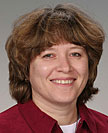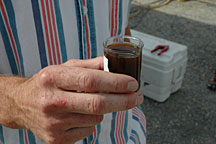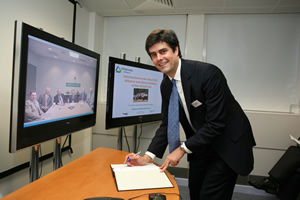Research
Highlights...

|
PNNL's
Julia Laskin
|
|
 |
Number 248 |
November 19, 2007 |
|
Molasses. It's not just for cooking anymore
|
| "Molasses used as a key ingredient in groundwater cleanup" |
Enough molasses to make 88,000 batches of gingerbread cookies is helping researchers at Pacific Northwest National Laboratory conduct a safe and very inexpensive groundwater cleanup technique. PNNL scientists are injecting the sticky solution into the groundwater in the north portion of the Hanford Site in Washington state. The mixture of 5,500 gallons of molasses and water is expected to alter subsurface contaminants through biostimulation resulting in cleaner groundwater which is migrating toward the Columbia River. Scientists expect bacteria in the soil to consume the sugary solution and produce a favorable subsurface environment which will aid in the conversion of hexavalent chromium into a nontoxic form. The injection should also help invigorate an existing underground chemical barrier that uses natural iron in the aquifer to perform the chemical conversion.
[Staci West, 509/372-6313,
staci.west@pnl.gov] |
|
By the light of the moon
The moon is more than just a pretty ball in the sky—it could become a unique target for calibrating gamma-ray telescopes, thanks to researchers at DOE's Stanford Linear Accelerator Center. The moon acts as a big, bright "standard candle"—an object with a known gamma-ray output. That candle's exact brightness was recently derived by physicists Igor Moskalenko of SLAC and Troy Porter of UC Santa Cruz. Having such a standard provides a unique tool to calibrate telescopes, and can prove a useful cross-check with other calibration methods. If the moon through a telescope matches Moskalenko and Porter's calculations, then images of the rest of the galaxy are probably correct. If the moon looks funny, then it's time to adjust the instrument.— Amber Dance [Kelen Tuttle, 650/926-2585,
kelen.tuttle@slac.stanford.edu] |
|
Partnership reaches across Atlantic
|
|
ORNL Director Thom Mason signs the memorandum of understanding during a visit to the Imperial College of London for the launch of the Global Lab. In the background are Oak Ridge officials looking on via teleconference from ORNL. |
Scientists in London will be able to use and manipulate, in real-time, leading multi-million dollar scientific instruments and technology in the United States following the official launch of the Global Lab at Imperial College London. The Global Lab is part of the AtlanTICC Alliance, a sustainable energy research consortium comprising Imperial College London, Georgia Institute of Technology and DOE's Oak Ridge National Laboratory. At the ceremony one of the world's leading electron microscopes at ORNL, the JEOL 2200FS Aberration Corrected Electron Microscope, was controlled and manipulated from London. This extremely powerful microscope focuses electrons into a probe that is less than 0.0.1nm in diameter, which is less than the length of a typical chemical bond. By scanning this probe across a sample, it is possible to analyze individual atoms. [Larisa Brass, 865/574-4163,
brasslm@ornl.gov] |
|
More "resilience" to disaster
A new initiative at DOE's Oak Ridge National Laboratory could help avert disasters in Tennessee, Mississippi and South Carolina and also lead to more information about climate change. The new Community and Regional Resilience Initiative will be implemented in Gulfport, Miss., Memphis, and Charleston, S.C., to increase "resilience"—the ability to prepare for, respond to and quickly recover from natural and man-made disasters—of the three communities.These partner communities will help develop and share essential knowledge, best practices, tools and techniques to strengthen a community's ability to withstand a major disaster event with minimal downtime to basic government and business services.
[Mike Bradley, 865/576-9553,
bradleymk@ornl.gov]
|
|
|
PNNL researcher explores behavior of complex molecules
 |
Julia Laskin |
From cold winters in St. Petersburg, Russia, to sweltering summers in southeastern Washington State, Dr. Julia Laskin's career in science has been an interesting journey. Her latest trip landed her on the steps of the White House for a photo-op with the President.
Laskin received the Presidential Early Career Award for Scientists and Engineers for her research on the fundamental aspects of the reaction kinetics and dynamics of activating and dissociating complex molecular ions . Her work at Pacific Northwest National Laboratory provides a basis for the development of analytical techniques for improved characterization of synthetic and natural polymers, petroleum, biofuels and other complex samples using mass spectrometry.
“We are honored to have her expertise and enthusiasm in advancing scientific frontiers,” said Associate Laboratory Director for Fundamental and Computational Sciences Doug Ray. Her work at PNNL began in 1999 as a postdoctoral research associate in the Department of Energy's Environmental Molecular Sciences Laboratory, a national scientific user facility at PNNL.
With help from her mentors and colleagues, she converted a former storage room in EMSL into a laboratory and participated in the design and construction of unique instrumentation, including a novel mass spectrometer specifically configured for studying ion-surface collisions. She explored collisional activation and dissociation of biopolymers and other complex molecules by combining detailed experimental studies with rigorous theoretical modeling of the data.
As a winner of the U.S. government's highest honor for researchers at the start of their career, Laskin received a citation, a plaque and a commitment for continued funding of her work for five years. Laskin was one of four DOE Office of Science-funded staff members receiving the award this year.
Submitted by DOE's
Pacific Northwest National Laboratory
|
|





